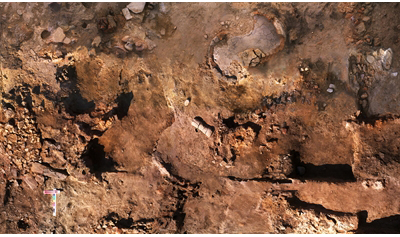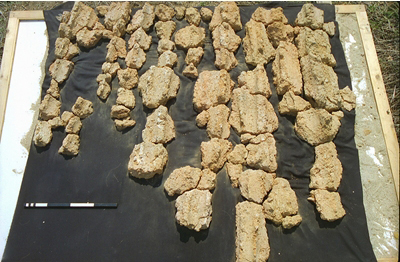Neolithic : The houses
Plans and techniques of construction
 The remains that came into light in sector V/West did not provide a complete habitation plan of the Late Neolithic I period, but they did reveal several rectangular buildings made of earth on a wooden frame. This kind of construction is found all over the Balkans during this period. These remains further established that houses were not always built with the wattle-and-daub technique, attested in Dikili Tash and elsewhere in the region. Walls could also be constructed over a frame of posts tightly joined together by a few crosspieces and covered with building clay, sometimes preserving traces of a coloured coating. Other kinds of architectural decoration have also been recorded, for example, a real bucranium coated with clay and applied as a trophy.
The remains that came into light in sector V/West did not provide a complete habitation plan of the Late Neolithic I period, but they did reveal several rectangular buildings made of earth on a wooden frame. This kind of construction is found all over the Balkans during this period. These remains further established that houses were not always built with the wattle-and-daub technique, attested in Dikili Tash and elsewhere in the region. Walls could also be constructed over a frame of posts tightly joined together by a few crosspieces and covered with building clay, sometimes preserving traces of a coloured coating. Other kinds of architectural decoration have also been recorded, for example, a real bucranium coated with clay and applied as a trophy.
 Houses are often equipped with bins or pits for storage, built above or dug into the floor, ash pits associated to combustion structures (hearths or ovens), and waste pits. An oven associated with a platform, storage jars, millstones, and kitchenware often occupies a central place in the room and seems to constitute the focal point of everyday life, which is hardly surprising. The best example comes from layer 3 in sector V/West, with an oval-shaped oven with walls preserved up to a height of 20 cm. Combustion structures were sometimes also situated outside the houses.
Houses are often equipped with bins or pits for storage, built above or dug into the floor, ash pits associated to combustion structures (hearths or ovens), and waste pits. An oven associated with a platform, storage jars, millstones, and kitchenware often occupies a central place in the room and seems to constitute the focal point of everyday life, which is hardly surprising. The best example comes from layer 3 in sector V/West, with an oval-shaped oven with walls preserved up to a height of 20 cm. Combustion structures were sometimes also situated outside the houses.
The four Late Neolithic II houses found in Sector 6 are also rectangular in plan and constructed with building clay on a frame of joint posts. They are the first in Northern Greece that allowed the recording of detailed information about their function.

